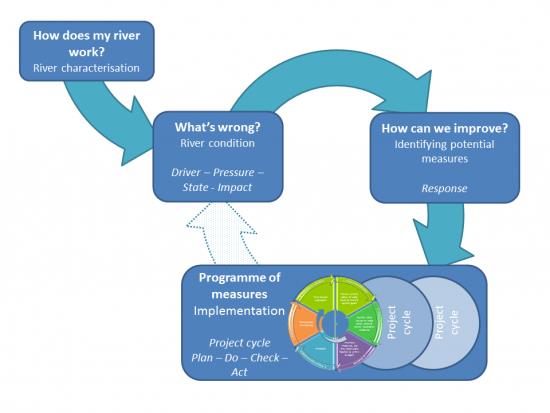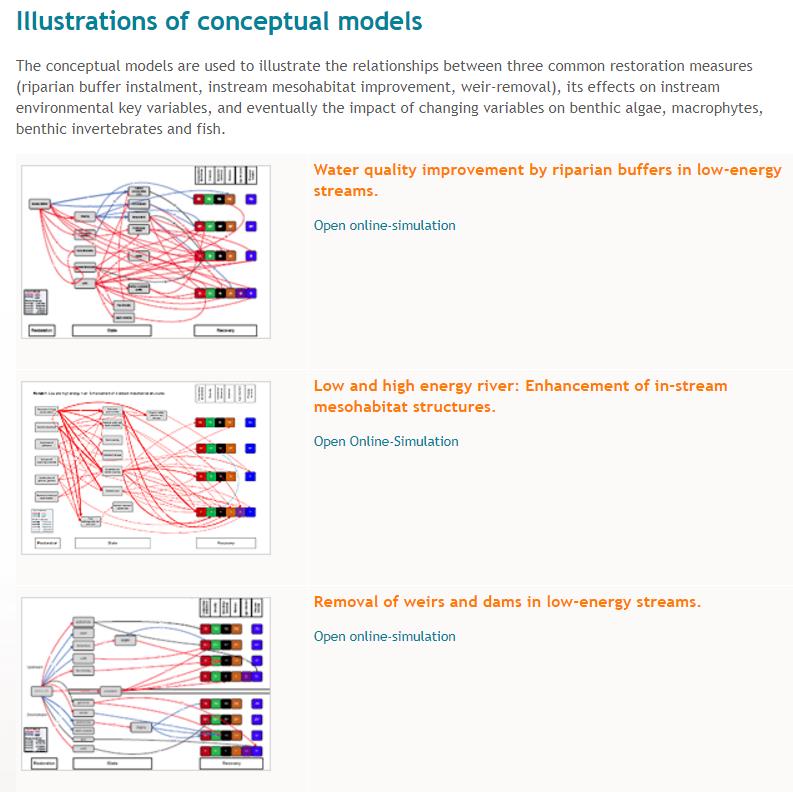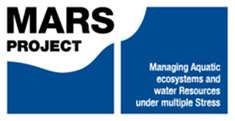What is a response?
In the driver-pressure-state-impact-response (DPSIR) framework, response describes the actions taken by society or policy makers as the result of an undesired environmental impact. A response can affect any part of the DPSIR chain between driving forces and impacts.
An example of a response is in the EU Water Blueprint which concentrates on better integration of water policy objectives into other European policies (so-called cross-compliance) to ensure that a sufficient quantity of good quality water is available for people's needs, the economy and the environment throughout the EU. (EC 2012) .
Responses related to pressures can be grouped into restoration and mitigation measures. Restoration aims to guide an ecosystem to a more natural, diverse and/or resilient state, as a response to environmental degradation. Restoration occurs on a range of scales, and to a diverse range of goals. Common aquatic restoration strategies include the restoration of riparian zones, environmental flows, stream meanders, dam removal, reductions in abstraction, and the management of invasive species.
Mitigation measures reduce the impact of the pressure and mostly serve a specific aim, but do not necessarily make the ecosystem more natural. An example of a mitigation strategy is the installation of fish passes in dams and weirs in rivers to allow migratory fish to move up- and downstream (see e.g. Freshwater Blog on Mitigating the ecological effects of water storage pressures)
Below is a list of online resources outlining relevant aspects of different restoration and mitigation measures.

Screenshot of the home page of the RESTORE WIKI (status 12 Sept 2017). Figures indicate the number of restoration projects.

Fig. 2: The diagram above shows the restoration project planning cycle at a catchment scale using a five step approach (Friberg et al. 2016).
Database on river restoration projects
As part of the LIFE+ RESTORE project a WIKI on river restoration projects has been created and populated. The RESTORE WIKI is an interactive source of information on river restoration schemes from around Europe. The database can be explored by different categories: country; monitoring or implementation costs, natural flood risk management and many more. It is also possible to add new restoration case studies. As of September 2017 the database holds information on more than 1,000 restoration case studies.
Website: https://restorerivers.eu/wiki/index.php?title=Main_Page
Catalogue of hydromorphological restoration measures for rivers, streams and floodplains
The FP7 REFORM project focused on cost-effective monitoring of hydromorphological modifications of rivers and streams and effective river and stream restoration measures (www.reformrivers.eu). Following a river characterisation and status assessment the need for restoration is identified (Figure 2. The project has prepared 60 factsheets for restoration measures for the following aims:
- Water flow quantity improvement
- Sediment flow quantity improvement
- Flow dynamics improvement
- Longitudinal connectivity improvement
- River bed depth and width variation improvement
- In-channel structure and substrate improvement
- Riparian zone improvement
- Floodplains/off-channel/lateral connectivity habitats improvement
The factsheets are online available at: http://wiki.reformrivers.eu/index.php/Category:Measures
Natural Water Retention Measures
Natural Water Retention Measures (NWRM) are multi-functional measures that aim to protect and manage water resources and address water-related challenges by restoring or maintaining ecosystems as well as natural features and characteristics of water bodies using natural means and processes. The main focus of NWRMs is to enhance, as well as preserve, the water retention capacity of aquifers, soil, and ecosystems with a view to improving their status. To share information, an online platform has been created, holding a catalogue of NWRM, case studies and guidance on implementing NWRM.
Website: http://nwrm.eu/
Overview of river restoration and dam removal in the United States
Dams have a fundamental impact on a river by blocking the movement of fish and other aquatic species, inundating river habitat, impairing water quality, and altering the flow regime of water and sediment necessary to sustain river life. There are currently more than 90,000 dams in the USA. Many no longer serve the purpose for which they were originally built.
American Rivers directly contributes to removing dams (it has already been involved in the removal of more than 200), and assists government agencies and non-profits to expand their capacity to restore rivers through training and focused program assistance.
For an overview of dam removal please consult the WIKIPEDIA page on Dam Removal.

Fig.4: WISER Conceptual models based on documented relationships for restoration measures, environmental state and biotic response.
Natural water retention measures
The general lack of available results and findings from integrated, well-designed and long-term restoration schemes is striking. A conceptual framework can help to address this problem. The EU FP5 project WISER developed conceptual models according to the DPSIR approach for three common river restoration measures: riparian buffer management; in-stream meso-habitat enhancement; and the removal of weirs and small dams.
The framework highlights recurrent cause–effect chains: the commonly observed relationships of restoration measures (response) and their effects on abiotic and biotic conditions (status - impact).
Four major questions have been addressed:
- Which organisms show clear recovery after restoration?
- Is there evidence for qualitative linkages between restoration and recovery?
- What is the timescale of recovery?
- If restoration fails, what are the reasons?
Such conceptual models can provide useful new tools for devising more effective river restoration, and for identifying avenues for future research in restoration ecology in general (Feld et al. 2011).
Further reading
Scientific articles and reports:
EC (2012). A Water Blueprint for Europe (Download report, 1.28mb)
Feld, C.K., S. Birk, D.C. Bradley, D. Hering, J. Kail, A. Marzin, A. Melcher, D. Nemitz, M. L. Pedersen, F. Pletterbauer, D. Pont, P.F.M. Verdonschot & N. Friberg (2011). From natural to degraded rivers and back again: a test of restoration ecology theory and practice. Advances in Ecological Research, 44(3), 119-209. https://doi.org/10.1016/B978-0-12-374794-5.00003-1 (Read abstract)
Friberg, N., N.V. Angelopoulos, A.D. Buijse, I.G. Cowx, J. Kail, T.F. Moe, H. Moir, M.T. O’Hare, P.F.M. Verdonschot, C. Wolter (2016). Effective River Restoration in the 21st Century: From Trial and Error to Novel Evidence-Based Approaches In: A.J. Dumbrell, R.L. Kordas & G. Woodward [eds.] Large-Scale Ecology: Model Systems to Global Perspectives. Advances in Ecological Research 55: 535-611. http://dx.doi.org/10.1016/bs.aecr.2016.08.010 (Read abstract)
Selected Freshwater Blogs on restoration and mitigation:
- Hydropower and fish: reporting on a Brussels workshop (July 2017) (External website)
- Mitigating the ecological effects of water storage pressures (Mar 2017) (External website)
- Lake Restoration and Management in a Changing Climate (Mar 2017) (External website)
- Restoration of the Lippe River in Germany doubles fish populations (Feb 2017) (External website)
- Conservation and restoration of riparian zones under multiple pressures (Nov 2016) (External website)
- Habitat quality is more important than habitat length in river restoration projects (Oct 2015) (External website)
- What influences the ecological success of river restoration? (Sep 2015) (External website)
Other websites:
American Rivers (External website)
European Commission - A Water Blueprint – taking stock, moving forward (External website)
Natural water retention measures (External website)
REFORM (2014). Measures (External website)
RESTORE (2017). Database on river restoration projects (External website)




